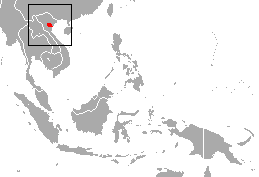Delacour's langur facts for kids
Quick facts for kids Delacour's langur |
|
|---|---|
 |
|
| Conservation status | |
| Scientific classification | |
| Genus: |
Trachypithecus
|
| Species: |
delacouri
|
 |
|
| Delacour's langur range | |
The Delacour's langur (also called Delacour's lutung) is a type of Old World monkey that lives only in northern Vietnam. Its scientific name is Trachypithecus delacouri. This special monkey is named after a French-American bird expert, Jean Théodore Delacour. Sadly, it is a critically endangered species, meaning it's very close to disappearing forever.
Contents
What Delacour's Langurs Look Like
Delacour's langurs are a bit bigger than their close relatives, like the François' langur. They look quite similar to them in other ways.
Adult langurs are about 57 to 62 centimeters (22 to 24 inches) long from head to body. Their tails are even longer, measuring about 82 to 88 centimeters (32 to 35 inches).
Male langurs usually weigh between 7.5 and 10.5 kilograms (16.5 to 23 pounds). Females are a little smaller, weighing from 6.2 to 9.2 kilograms (13.5 to 20 pounds).
Their fur is mostly black. They have white markings on their faces. They also have creamy-white fur on their bottoms and the outside of their thighs. Female langurs have an extra patch of pale fur in their pubic area.
Like other similar monkeys, Delacour's langurs have a crest of long, upright hair on their foreheads and the top of their heads. This crest is taller and narrower than in other species.
Where Delacour's Langurs Live
Delacour's langurs live only in Vietnam. You can find them in an area of about 6,000 square kilometers (2,300 square miles). This area includes the capital city of Hanoi and provinces like Ninh Bình, Hà Nam, Hòa Bình, and Thanh Hóa in northern Vietnam.
The biggest group of these langurs lives in the Van Long Nature Reserve in Ninh Bình. Here, they live in open forests up to 328 meters (1,076 feet) high. Their home is mostly made of limestone karst formations, which are special rocky landscapes.
How Delacour's Langurs Behave
Delacour's langurs are active during the day. They often spend their daytime sleeping inside limestone caves. If there are no caves, they will sleep on bare rocky surfaces.
They are plant-eaters. About 78% of their diet is made up of leaves. They also enjoy eating fruits, seeds, and flowers. These monkeys eat leaves from many different types of plants. This shows that their need for limestone habitats is not just about their food.
In the past, Delacour's langurs lived in groups of up to 30 monkeys. These groups often had both males and females. However, groups with only one male are more common now. Some small groups made up of only males have also been seen.
Today, the typical group size is much smaller, usually with only about four to 16 members. Males protect their group's territory from other langurs. They often stand watch on rocky outcrops. If they see other langurs, the males will first try to scare them away. They do this with loud hoots and visual displays. If that doesn't work, they will chase and fight.
Within their own group, langurs stay close by grooming each other and playing.
Even though they live in forests, Delacour's langurs spend most of their time on the ground. They only go into trees sometimes. When they travel through trees, they swing using their hands. They use their tails to help them balance when climbing over steep, rocky areas. This helps them move faster than other related monkeys.
Baby Langurs
Female langurs give birth to one baby after being pregnant for 170 to 200 days. Baby langurs are born with bright orange fur. They are also precocial, meaning they are quite developed at birth. Their eyes are open, and their arms are strong.
Their fur starts to turn black when they are about four months old. They are probably weaned (stop drinking their mother's milk) when they are 19 to 21 months old. At this time, the mother is usually ready to have another baby. However, the baby's fur doesn't get its full adult pattern until they are about three years old.
Females can start having babies when they are four years old. Males can start having babies when they are five years old. Delacour's langurs can live for about 20 years.
Protecting Delacour's Langurs
The number of Delacour's langurs has gone down very quickly in recent years. In 2006, only 19 groups were known. Their total population dropped by about 20% between 1999 and 2004. Since then, two of these groups have completely disappeared from their local areas. Now, only the group in the Van Long Nature Reserve might be big enough to survive long-term.
The IUCN has listed Delacour's langurs as critically endangered. The biggest danger to them is hunting. People hunt them for traditional medicine. Losing their forest homes and the growth of tourism in their areas are also potential risks.
As of 2010, experts believed that fewer than 250 of these animals were left in the wild. There were also nineteen langurs living in zoos or special centers.


